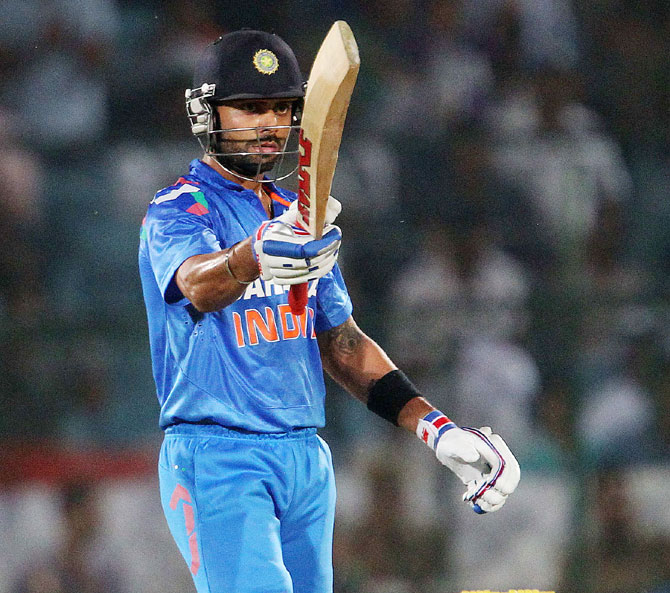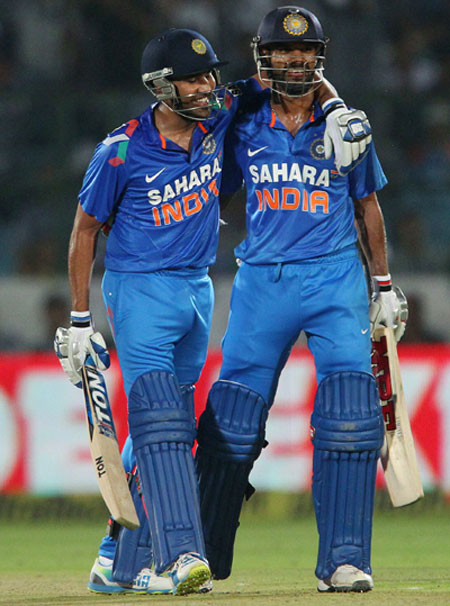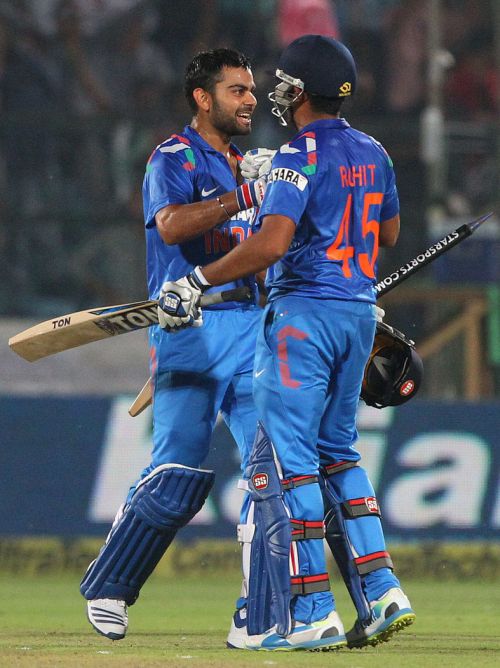 | « Back to article | Print this article |
Stats: Kohli scores fastest ODI hundred by an Indian
India's stunning nine-wicket victory over Australia in Jaipur on Wednesday was a record-breaking affair. The visitors had no answer to the Indian batsmen's fury.
-'We lost it the moment Virat came into bat'
-Shikhar set it up; Rohit and Virat finished it!
-'Happy that I converted my start into a big score'
PHOTOS: India crush Australia in record run chase to level series
During the course of the high-scoring match several new records were established.
Take a look at some statistical highlights.
# Virat Kohli scored the fastest ODI century by an Indian against Australia from 52 deliveries. The 100 runs were assisted by eight boundaries and seven sixes.
# The 25-year-old broke Virender Sehwag's 60-ball century record against New Zealand in 2009.
# Kohli’s ton is the seventh fastest in ODI cricket.
Sharma-Dhawan in India's highest opening partnership vs Australia
# Shikhar Dhawan's 95 off 86 balls is his first fifty in ODIs in India.
# In Indian wins, Dhawan averages 51.56, his tally being 825 in 17 matches, including three centuries and four fifties.
# Dhawan's tally of 809 (ave.53.93) in 16 matches, including three hundreds and three fifties, is the second highest by an Indian batsman in ODIs in 2013, next only to Virat Kohli -- 850 (ave.50.00) in 24 matches.
# Rohit Sharma and Dhawan put on 176 -- India's highest opening partnership vs Australia in ODIs, eclipsing the 175 between Sourav Ganguly and Sachin Tendulkar at Kanpur on April 7, 1998.
# Rohit and Kohli put on a second-wicket stand of 186 (unbroken) -- India's highest partnership for any wicket in ODIs at Jaipur.
The partnership is also the highest for the second wicket by any pair at this venue.
Jaipur is India's favourite hunting ground
# India won three consecutive ODIs at Jaipur for the first time -- one each vs South Africa, New Zealand and Australia.
# India's nine-wicket triumph is their biggest in terms of wickets against Australia in ODIs.
# India enjoy a 100 per cent record against Australia at Jaipur, winning both their ODIs there.
# India (362 for one) recorded their highest successful chase in ODIs, eclipsing the 330 for four vs Pakistan at Mirpur on March 18, 2012. The score is the second highest successful chase in ODIs, behind South Africa's 438 for nine with one ball to spare against Australia, at Johannesburg on March 12, 2006.
# India achieved the target successfully for the loss of one wicket -- the highest ever for the loss of one wicket in ODIs, eclipsing Sri Lanka's 348 for one vs India at Kingston on July 2, 2013.
# India successfully chased a total of 300 or more against Australia in ODIs for the first time, eclipsing the 292 for five at Visakhapatnam on October 20, 2010.
# India's run-rate of 8.32 is the fourth highest in successful chase of 300 or more in the history of ODIs.
Hughes posted his maiden half-century away from home
# Australia's 359 for five is now the second highest by any team at Jaipur. They emulated their highest total vs India in ODIs, having scored 359 for two at Johannesburg on March 23, 2003 and 359 for five at Sydney on February 8, 2004.
# Forty-eight boundaries (36 fours and 12 sixes) were recorded in Australia's innings -- their highest against India. Fifty boundaries (39 fours and 11 sixes) were registered in India's total -- their highest vs Australia in ODIs.
# Overall, the match witnessed 75 fours and 23 sixes; 438 runs were through boundaries in the match -- the third highest tally in this way in an ODI.
# The South Africa-Australia game at Johannesburg on March 12, 2006 witnessed 504 runs through boundaries – 87 fours and 26 sixes -- a record.
# Phillip Hughes (83 off 103 balls) posted his maiden half-century away from home in six ODIs.
# Aaron Finch (50 off 53 balls) registered his second fifty in ODIs.
# Glenn Maxwell (53 off 32 balls) posted his third fifty in ODIs -- his first vs India.
# Of the top six successful chases in ODIs, five have been registered against Australia.



